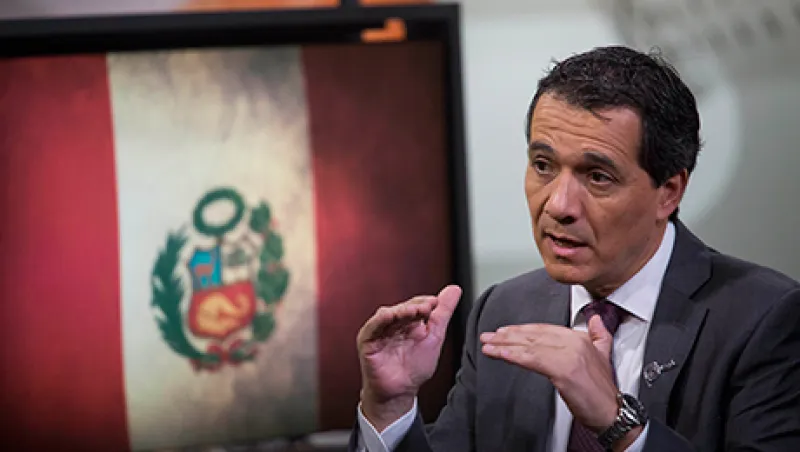The sonorous morning chimes from the massive, 16th-century Cathedral of Lima — arguably, Latin America’s greatest rendition of ecclesiastical architecture — echoed through the capital’s main square. Nearby, along the narrow streets of the historic center, restoration work was under way on Spanish colonial town houses with their signature enclosed wooden balconies. Opposite one of those town houses, in a seven-story modern building with a dull, tan façade, Minister of Economy and Finance Alonso Segura met recently with Institutional Investor Senior Contributing Writer Jonathan Kandell to discuss how Peru is coping with its economic slowdown.
Institutional Investor: The International Monetary Fund and World Bank say Latin America faces a new normal of low economic growth rates. How can Peru remain a high-growth exception in the region?
Segura: Peru’s growth in the past has been broad-based. While commodities have been important, we have been able to diversify the economy. And we have government strategies in place to boost productivity and competitiveness to create additional avenues of growth. We are making important investments in infrastructure and education, for instance. But in the short term, there are specific factors in Peru that are affecting growth. We are in an election cycle, and this means a slowdown in private investment as businesses wait and see what the next government will look like in 2016.
But won’t mining have to remain the engine of growth even if copper prices keep falling?
Keep in mind that even though copper prices are down, we are a highly competitive country in terms of production costs. And we have major new projects and expansions of existing mines in the pipeline. So mining production will go up and continue to push GDP growth this year and next. Having said this, infrastructure should surpass the mining sector as the main driver of new investments in 2016. Those infrastructure projects are either public investment projects or PPPs — public investment projects carried out jointly with the private sector. That will support growth through 2017. And by that time, with elections over, private investment should rebound.
Compared with other Latin American countries and emerging markets, how vulnerable is Peru to a rise in U.S. interest rates?
We are less vulnerable, for several reasons. For one thing, we are an investment-grade country and are tied with Mexico with the second-highest credit rating in Latin America. So whatever adjustment in U.S. interest rates, there should be a lower impact for us in terms of spreads for our bonds compared to U.S. Treasuries. Also, we have ample access to capital markets and have been able to fund significant projects, such as the subway system in Lima, without any difficulty. And another factor is that we have taken measures, like prefunding the budget, to anticipate as much as possible any interest rate rise.
The growth of consumption — particularly, middle-class consumption — has been a notable phenomenon in Peru for the past dozen years. Can it continue even if mining export revenues fall?
There has been a consumption boom driven by the greatest economic growth in our history. But now the banks’ consumer lending portfolios have started to slow down. More attention is being paid to improving the quality of the loan portfolios. Another factor is that because we have a partially dollarized economy, efforts are under way to guard against currency mismatches in consumer loan portfolios. Sol accounts are being pushed to increase much faster than dollar accounts. So we are seeing a deceleration in consumer spending, though it is still growing at somewhat less than 4 percent, compared to somewhat above 4 percent last year.
Local opposition to mining and oil and gas projects is stronger than ever, even though Peru has some of the most enlightened prior consultation and tax distribution policies in Latin America. What more can the government do?
Some of these processes are new and cumbersome. They involve both social and political issues. We need to work harder to institutionalize our approach toward local communities. We cannot operate by ad hoc decrees or initiatives. But the fact is that successful projects don’t make the news. People only hear about the projects that face opposition, either from local communities or extremists or corrupt leaders.
Will there be continuity in economic and investment policies no matter who the next president is?
Core economic policies have remained in place for a quarter of a century. Regardless of who wins in 2016, we can expect these policies will continue. But whoever comes in will face a tougher economic environment. This is the fifth consecutive year of a decline in commodity prices, and that is something that hasn’t happened over the past 20 years.






